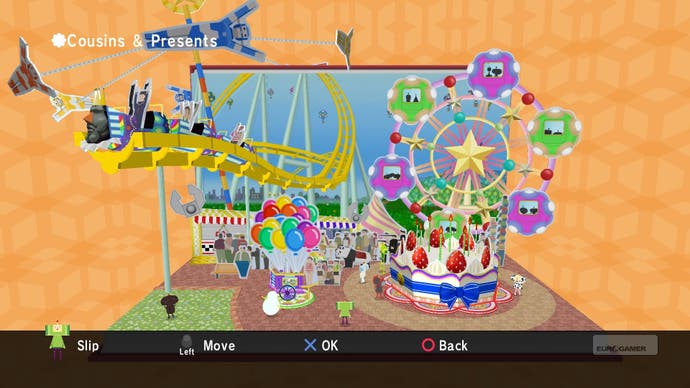Katamari Forever
Infinite Circle?
Novelty is introduced by framing the game's basic collect 'em up challenge in different ways. In the original game, the goal was always related to size: grow your Katamari by 5 metres in two minutes, and so on. By contrast, in Forever, you'll often need to judge objects by a variety of other criteria.
One level asks you to create a ball of great value so you search the town for cash registers, diamond rings and expensive perfumes, ignoring the larger, everyday items that are only worth a few hundred Yen apiece. In another you're asked to grab as many animals as you can, raiding a zoo for new animal types. In yet another you must soak your Katamari with water and use it to paint life and greenery into a dusty desert bowl.
In other words, Namco changes the metaphor in order to broaden the scope and possibility of the design. Quite how significantly the metaphors have changed is illustrated by one later mission in which the king gives you 300 ,000 Yen to spend on picking up items. Everything in the level has an attached cash value and you can only 'roll up' as much as you can afford.
Of course, in design terms, it's just another way to limit player resources in order to frame a fresh collect 'em up challenge. But the bald consumerist target illustrates just how far from Takashai's initial message we've come.
Interspersed with new approaches to the core idea are more traditional stages, which give you, say, eight minutes to grow your Katamari ball from 30 cm to 800,000 metres. It's here that the game settles into its most satisfying rhythm as you move from rolling up paper clips to mountains in a short space of time. Each level has a number of 'cousins' who must be found, as well as 'present' boxes which unlock cosmetic items with which to adorn your characters.
The only new ideas introduced are a jump move and a new pick-up that temporarily turns your Katamari into a magnet, attracting all right-sized items in the vicinity to stick to the ball. The jump is welcome, easing as it does the keen frustration of being stuck in-between objects too large to roll up. However, the flick-the-six-axis execution method is far too vague so most players will end up resorting to the precision of the R-trigger instead.
Beyond of the individual stages, Katamari Forever is a let down. The rotatable planet around which the game's various destinations were positioned in previous games is gone, options now selected from an awkward pop-up book interface that adds nothing to the hub experience.

That said, the integration of leaderboards is smart and seamless (moreso than in the previous Xbox 360 title) and turns each level into an arcade-style challenge between friends. Even so, the weary proposition of once again tracking down all of the Prince's cousins and filling in the blanks on the collection pages of all the world's objects offers nothing fans of the series haven't done before.
The only rewards for extended play and effort are to be found in the unlockable novelty play modes such as the double speed 'Katamari Drive' and the time-limit free 'Eternal Katamari'.
As ever, the game's at its best when it allows you to slip into the calming repetition of the cleaning act, the catharsis of de-cluttering the game's environments broken only but the jabbing warning siren that fires for the final 30 seconds of each stage's time limit. In these moments the wonder and creativity of the first game still shines bright.
But elsewhere, the game's Japanese title is more applicable than its Western one: this is a tribute to Namco's game of the decade, a Greatest Hits compilation that, in pulling random stages and ideas from across the series lacks the coherency and streamlined form of its inspiration.
Its value for money is significant: there is a lot of bulk here, much of it excellent. But its wider value to gaming, to Takahashi's message and to the series it celebrates, is diminished. Like a balloon deflating, Katamari Forever feels like the series' final exhale, all puff and energy now gone from the idea. Metaphor!

